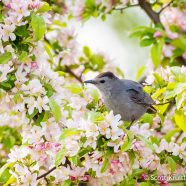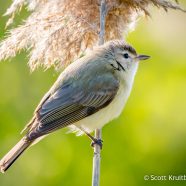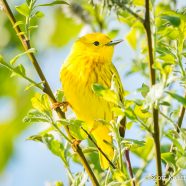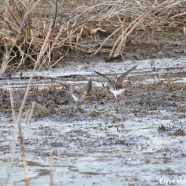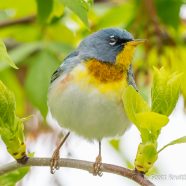Gray Catbird
This Gray Catbird (Dumetella carolinensis) certainly has the right idea here, picking out the most beautiful foraging place in all the land (or along the side of this road) to stop for a snack. The urban location made it all but certain this is a migrant individual, and let us hope it finds a yard with similar scenery…maybe even near you!
Read MoreWarbling Vireo
One of the more drab and plain May migrant birds in the Northeast is the Warbling Vireo (Vireo gilvus). Their subtle shades of brown, gray and olive combined with their tendency to hang up in the canopy makes it difficult to get an eyeful of the species – and you are far more likely to have an earful of their dynamic, fast and bold warbling song. This individual was foraging on a recent morning at a migratory hotspot, coming to eye-level and pausing on the phragmites just long enough for me to snap a shot. Scott Kruitbosch Conservation & Outreach Coordinator
Read MoreYellow Warbler Male
Here’s a more proper photo of a male Yellow Warbler perched in a willow shrub, befitting its status as undeniably common but unbelievably beautiful…
Read MoreDynamic Habitats
I got a text the other day from my dad saying, “Hey if you can, bring your boots over so we can investigate the beaver pond.” Behind my parents home is a beautiful wetland system that sits right in the valley, with forested hillsides surrounding. What was once a stream has since been turned into a marsh thanks to the work of some busy beavers. With dams on either end of the marsh, the water has been held back and has created great habitat for many birds, amphibians and reptiles. The marsh is full of snapping and painted turtles, peepers that are so numerous that their peeps...
Read MoreNorthern Parula
Here we have the Northern Parula (Setophaga americana) as photographed while feeding this past Sunday morning after a busy night of migration. These little birds sound like zippers with a hard ending, or sometimes the “That’s all Folks!” song from Looney Tunes after several fast da and be notes. Those white eye crescents stand out from afar on a blue gray bird with a white belly featuring that bright yellow throat and upper chest with a reddish brown band. Northern Parulas are a gleaning species, snatching insects and spiders from tree branches and especially caterpillars...
Read More



